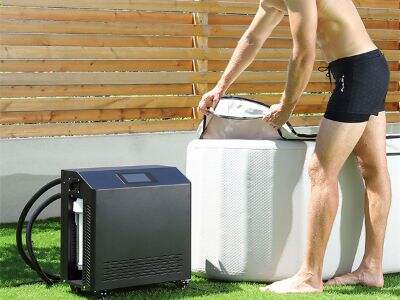Hey kids. You know what a water cooling chiller is, right? It’s what is known as a cool water chiller that cools down water and helps ensure that factories and buildings can operate as needed. It's like if your toys could only play if they were the right temperature - that's kind of like what a water cooling chiller does. Just like how you need to look after your toys and make sure they're clean and working properly, it's crucial to do the same for your water cooling chiller. With good care, you can help it function better and last longer. Let’s learn how to do that.
Data in the Frontlines – Simple Maintenance Steps
Proper maintenance of the water cooling chiller is crucial to help maintain the best performance and longevity. Here are parts you can do to ensure your chiller is in spectacular shape:
Clean the condenser coils — These are critical components of the Chiller Cooling Water. Over time they can become entangled with dust and dirt. You can use a soft brush or a vacuum cleaner to clean them carefully and keep them dirt free. This principles help the chiller to perform better.
Tip: Check the water levels: It is very important that the water in the chiller is at the right level. If the water level gets too low, the chiller can’t cool things down properly.” Inspect the levels periodically to ensure smooth operations.
Clean the filter: The chiller has a filter that helps keep the water clean. This filter is one you need to change regularly. If the filter is clean, then the water will flow and stay clean so that will assist in the functionality of the chiller.
Tighten loose bolts: Sometimes, chiller parts can work themselves loose. Do ensure to look for loose bolts and connections. That helps ensure the chiller will remain secure and not “fall apart when you use it,” when it’s running.
Common Problems — and Best Practices to Avoid Them
It is possible for chiller issues to arise baseline even with optimal chiller maintenance. Here are some common problems that you may face and ways in which you can fix them:
Corrosion: This occurs if the water is not properly treated, at this point it may even harm the water cooling chiller. To avoid the situation, you add special chemicals to the water and check the water pH often. The people who work for you make sure the water is balanced to prevent corrosion.
Scale build-up: Because of hard water, scale (a white, crusty build-up can develop inside the chiller's pipes. Water softeners are used to prevent the formation of scale. These contribute to reducing the hardness of the water, and preventing that crusty build-up.
Here are some common causes of cooling tower inefficiencies, and ultimately chiller inefficiencies, which you will want your service specialist to consider:Leaks: The pipes of the chiller can develop leaks, sometimes costly ones that can be difficult to detect, affecting cooling tower efficiency. Regularly will recommend inspection all piping and fittings for leaks. Noticing and repairing leaks early can lead to much greater savings in the repair process.
When to do it yourself and when to hire a professional
You could be a handy kid and do several things on your own, but some issues require a professional to resolve them. Below are some examples of when to call for help:
Electrical issues: If the chiller’s electrical system is malfunctioning, it is recommended to call in a professional. Electrical problems can be difficult and dangerous to deal with, so it is safer to allow someone who knows what they’re doing take care of it.
Refrigerant leaks: It’s always time to call the pros if you have a refrigerant leak. Refrigerant is hazardous, and repairing it safely requires specialized tools and expertise.
Significant repairs: If the chiller requires a major repair, such as the replacement of a major appliance, a professional can do it properly. They have the training and the tools to make the correction.
Keep Adjusting and Monitoring Regularly
No matter how well the Syochi chiller is working, it is best to regularly check it because it is critical. Monitoring it helps you notice any minor issues before they become major problems. In the same way you check your toys for whether they work fine, you must also check your chiller. In case everything runs smoothly, regular check-ups can contribute.
Energy Simplifies Maintainability and Scalability
It is like, do you understand what energy efficiency means? It means needing less energy to do the same work. Here are some simple steps to take to improve your chiller’s efficiency and save energy:
Keep the chiller cool: Be sure to put the chiller in a shaded spot away from direct sunlight. In cooler conditions, the chiller can operate more effectively.
Turn the temperature up: If you can keep things cool with a less cold chiller, that’s going to save you energy. This reduces energy used, and ensures everything is working properly.
Evaluate for a new chiller: In some cases, it would make sense to consider replacing with a new chiller. Newer models tend to be more efficient at conserving energy, which can help you save money in the long run.
 EN
EN
 AR
AR
 BG
BG
 HR
HR
 CS
CS
 DA
DA
 NL
NL
 FI
FI
 FR
FR
 DE
DE
 EL
EL
 HI
HI
 IT
IT
 JA
JA
 KO
KO
 NO
NO
 PL
PL
 PT
PT
 RO
RO
 RU
RU
 ES
ES
 SV
SV
 TL
TL
 IW
IW
 ID
ID
 SR
SR
 UK
UK
 VI
VI
 GL
GL
 HU
HU
 MT
MT
 TH
TH
 TR
TR
 FA
FA
 MS
MS
 GA
GA
 CY
CY
 BE
BE
 IS
IS
 EO
EO




